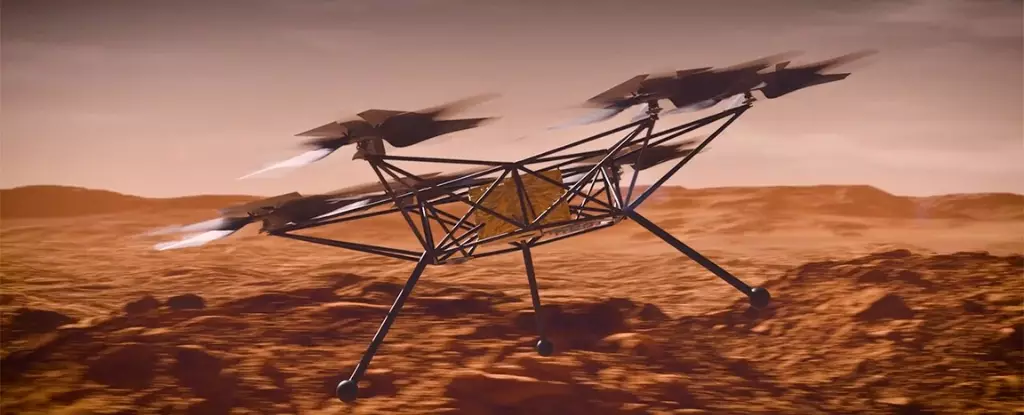In April 2021, NASA achieved a monumental milestone in the annals of space exploration with the successful flight of Ingenuity, a small drone-like helicopter on Mars. This pioneering craft not only unleashed the potential for powered flight on another planet but also opened new avenues for reconnaissance and data collection that were previously unreachable with traditional ground-based rovers. Following this initial triumph, NASA has unveiled a new rendering of its next-generation aerial vehicle: the Mars Chopper, set to take the science of extraterrestrial exploration to new heights—quite literally.
Ingenuity’s historic flight marked the first time any human-made object took to the skies of an alien world, soaring roughly ten feet above Martian soil. This achievement was more than just a technical feat; it was the first affirmation that controlled, powered flight is possible in the thin Martian atmosphere, which possesses less than 1% of the density of Earth’s atmosphere. Such a significant difference posed a complex set of engineering challenges for the creators of Ingenuity. The rotors had to be larger and spin faster than their Earth-bound counterparts to generate sufficient lift, showcasing human ingenuity in overcoming environmental constraints.
Throughout its operational life, Ingenuity completed 60 flights, serving as the eyes in the sky for the Perseverance rover. Each flight provided invaluable data that helped scientists identify potential sites of interest for further exploration. However, this initial success was merely the beginning of ambitious plans for aerial exploration on Mars and other celestial bodies.
The Mars Chopper, a conceptual enhancement of Ingenuity’s design, promises to push the boundaries even further. Unlike its predecessor, the new model is characterized by a more robust payload capacity and advanced functionalities that will allow it to carry scientific instruments, such as imaging devices and terrain analysis tools. These features are crucial for conducting comprehensive scouting operations that can significantly undergird future exploration missions, including human expeditions to Mars.
With a size akin to a compact SUV and equipped with six rotors that each have six blades, the Mars Chopper is engineered to collect even more lift than Ingenuity. This feature translates into an impressive payload capacity of up to 5 kilograms, enabling it to travel distances of around 3 kilometers. Such advancements not only represent a significant technical leap but also illustrate NASA’s commitment to refining aerial technology for planetary exploration.
Operating in Mars’ unwelcoming atmosphere is fraught with difficulties, primarily resulting from the planet’s unique environmental conditions. The far less dense atmosphere means that all mechanisms striving to achieve lift must be engineered to compensate for the extreme conditions. Furthermore, Martian dust—infamously fine yet abrasive—poses a risk to delicate equipment. As such, the design and materials used for the Mars Chopper must carefully balance durability and functionality, particularly in protection against local environmental hazards.
More than just a reconnaissance tool, the Mars Chopper exemplifies a shift in exploration paradigms; it’s designed not only to scout but also to analyze and map terrain with precision. This multifaceted utility positions aerial vehicles as crucial instruments in the scientific toolbox for future Mars missions, especially when human explorers prepare to set foot on Martian soil.
The development of the Mars Chopper reflects a collaborative effort between NASA’s Jet Propulsion Laboratory and the Ames Research Center, illustrating the synergy between innovation and scientific inquiry. This new aerial vehicle not only represents an evolution of prior designs but also stands to invigorate future exploration missions across the solar system. As exploration expands beyond Mars, the implications of this technology can potentially revolutionize our approach to visiting any alien worlds possessing a solid surface and an atmosphere conducive to aerial dynamics.
Having achieved initial success with Ingenuity, the Mars Chopper positions itself as a game changer in planetary exploration. The potential for enhanced aerial reconnaissance means that future missions will be significantly more effective in gathering data and evaluating conditions, thus facilitating human exploration. With remote aerial capabilities, exploration efforts can reach locations that rovers may find difficult to access, allowing us to unlock the mysteries of the Martian landscape and beyond. NASA’s Mars Chopper initiative could indeed herald a new era in our quest to explore other worlds.


Leave a Reply